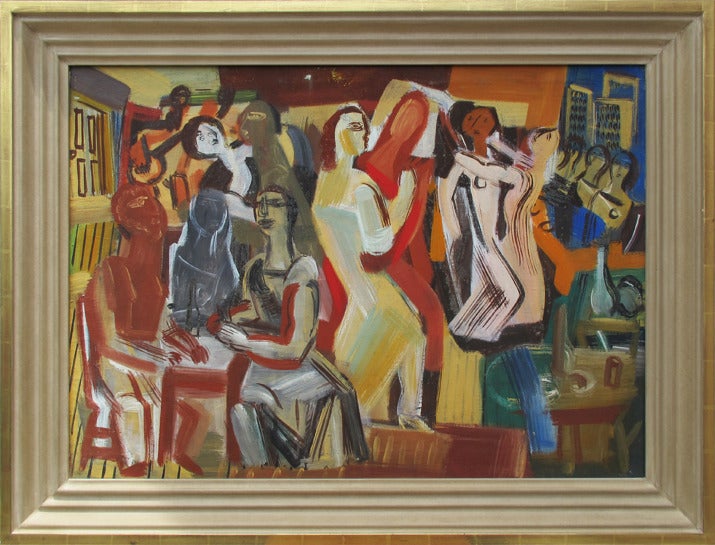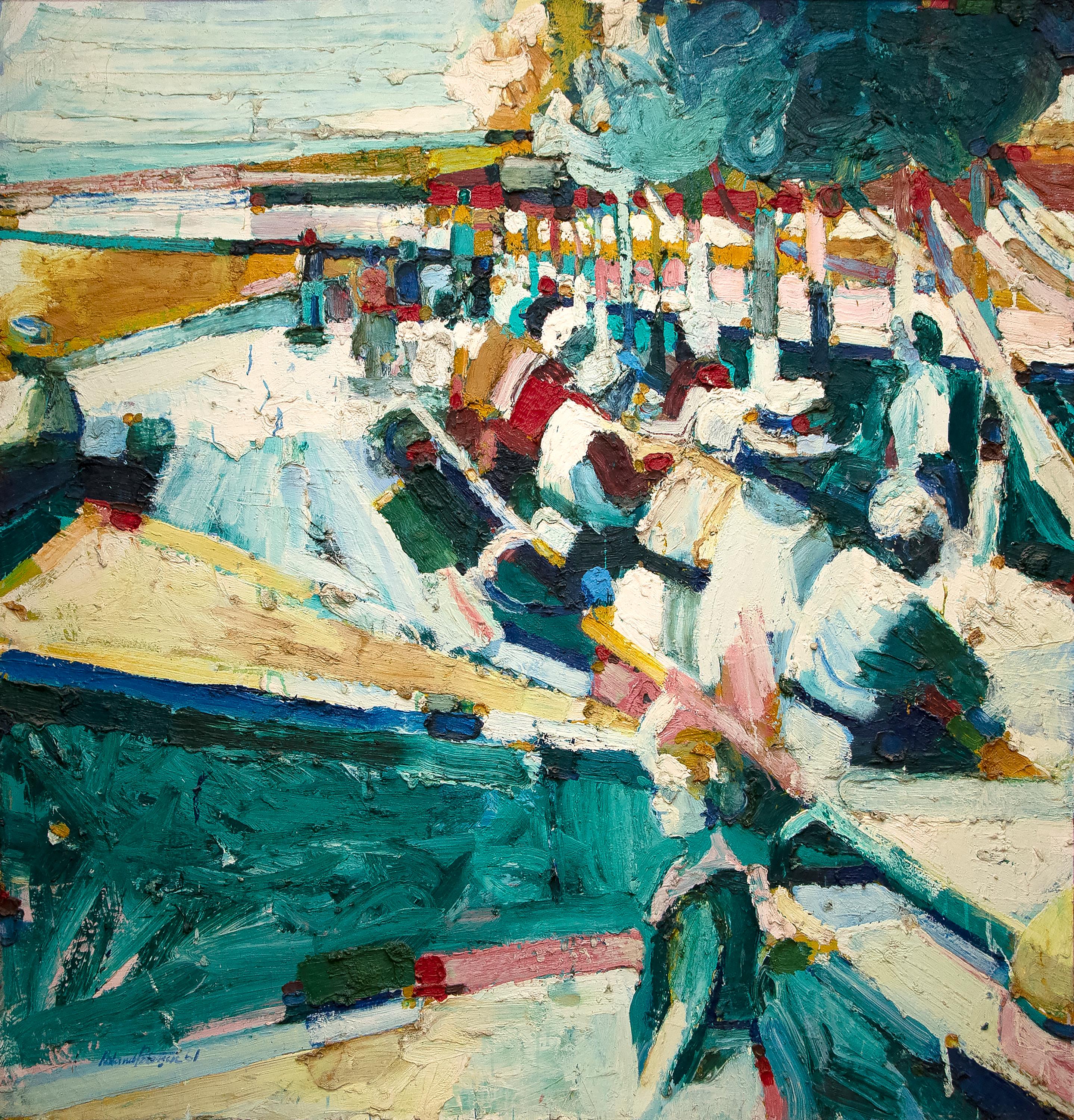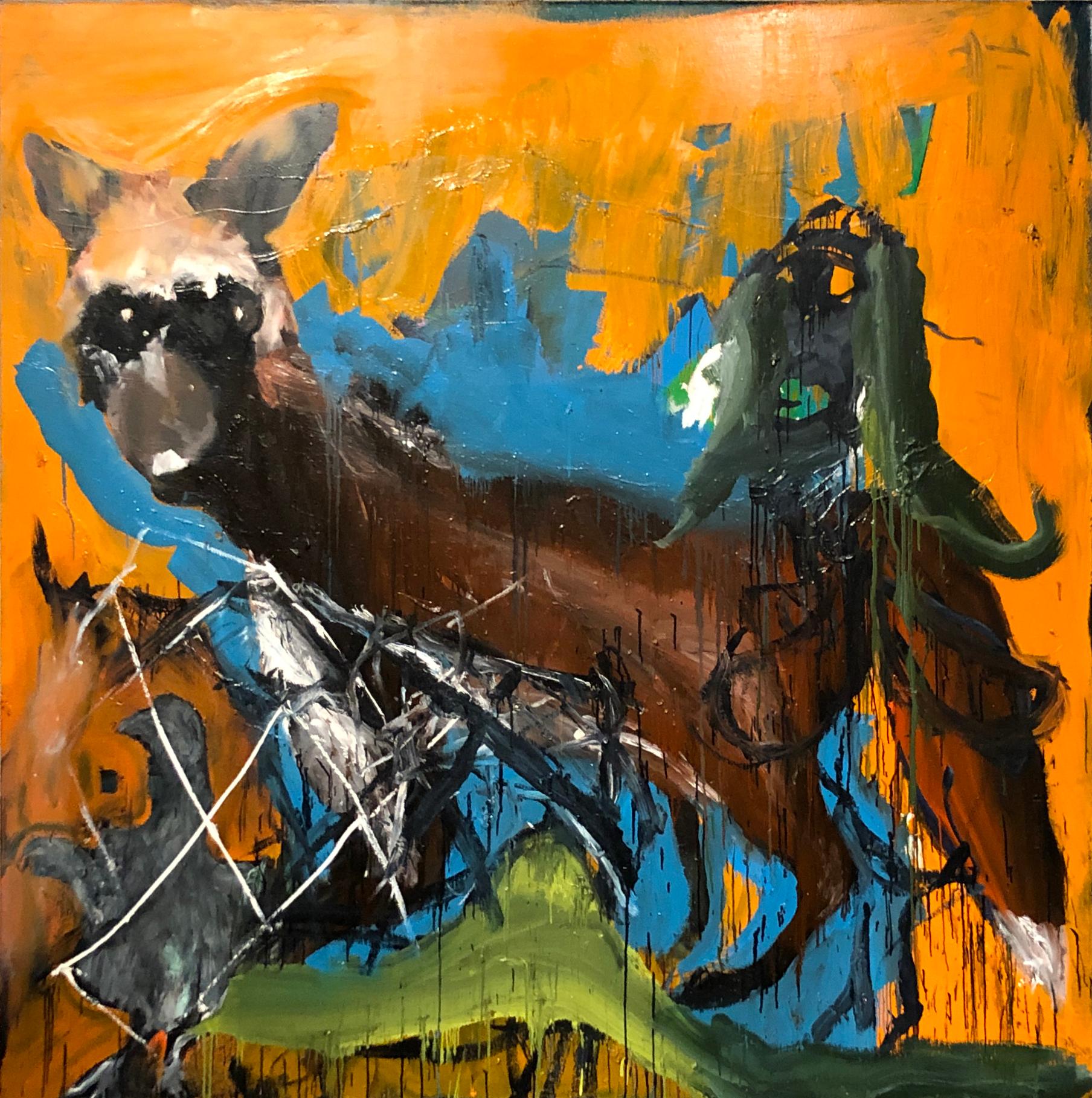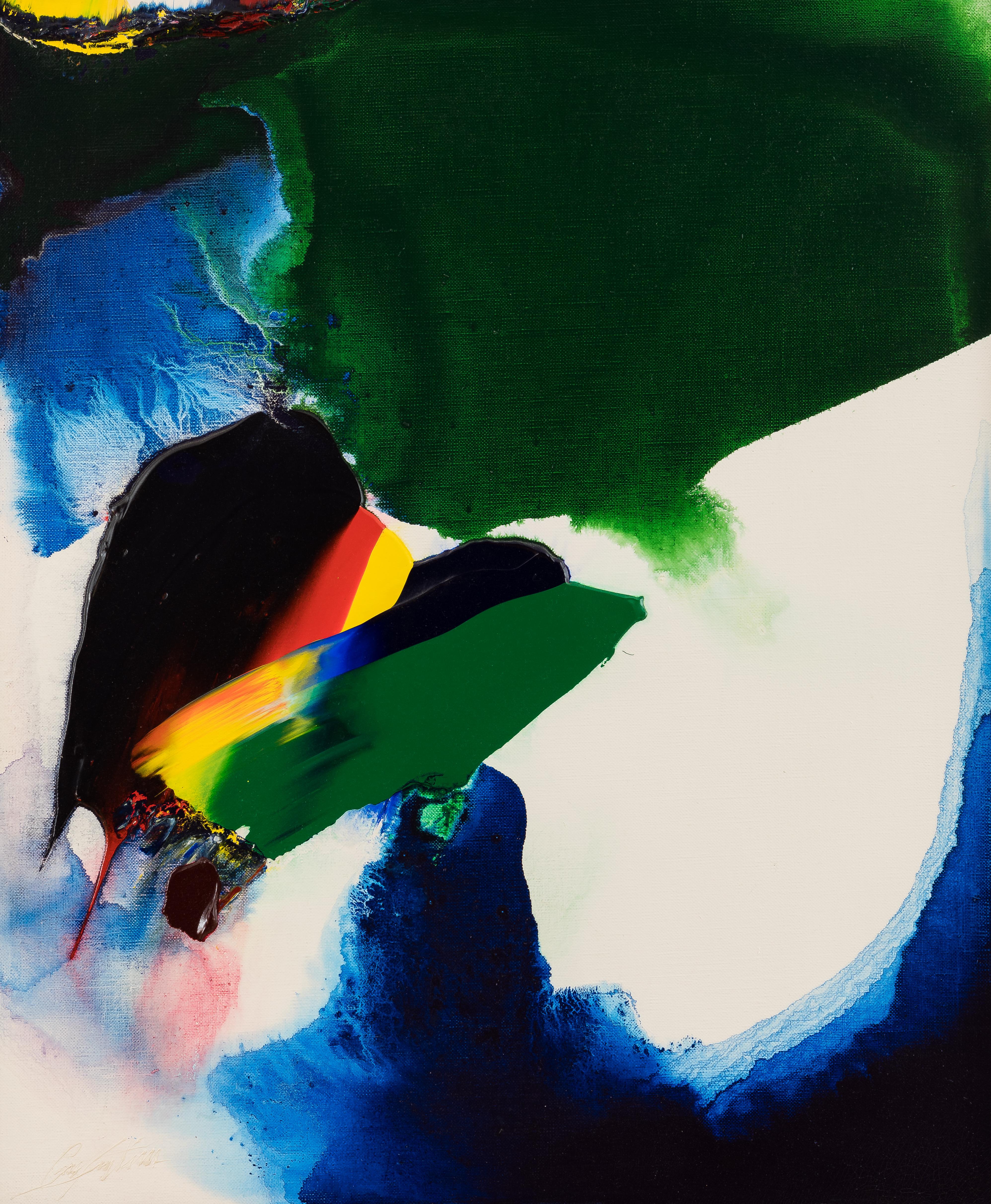Toshimitsu ImaiRed Composition by TOSHIMITSU ÏMAI - Contemporary, Abstract, Oil on canvas1963
1963
About the Item
- Creator:Toshimitsu Imai (1928 - 2002, Japanese)
- Creation Year:1963
- Dimensions:Height: 31.58 in (80.2 cm)Width: 21.78 in (55.3 cm)
- Medium:
- Movement & Style:
- Period:
- Condition:
- Gallery Location:London, GB
- Reference Number:1stDibs: LU261210088992
Toshimitsu Imai
Born in Kyoto, Japan, in 1928, Toshimitsu Imai was part of the 20th-century Japanese avant garde. He began his formal education at the Tokyo State Art Academy where he took up painting. His early works are characterized by colorful abstractions, reminiscent of Fauvism. In 1951, Imai was awarded the Kansai-Shinseisaku Prize and in 1952 the prize for the best new artist at the 15th Shinseisaku Salon.
Imai relocated to Paris in 1953, the same and subsequent year he exhibited at the Salon de L’Art Sacré. Meanwhile, he attended the Académie de la Grande Chaumière and the Sorbonne to study medieval history and philosophy. In 1955, Imai completely abandoned representational art in favor of abstraction. After meeting the art critic Michel Tapié via the artist Sam Francis, Imai was the first Japanese artist to join the Art Informel movement.
In 1956, Imai was called upon by the Japanese artist Taro Okamoto to curate an exhibition titled “The World: Today’s Art in Tokyo.” Artists such as Jean Dubuffet, Jean Fautrier, Lucio Fontana and Karel Appel gained important exposure in Japan. It was also in 1957, when Imai arranged for Tapié and the artists Georges Mathieu and Sam Francis to travel to Japan, that a connection between Art Informel and Gutai occurred. The Ashiya-based Gutai Art Association, formed in 1954, was proclaimed a kindred spirit and subsequently promoted internationally by Tapié. Founding members included Yoshihara Jiro, Kanayma Akira, Murakami Saburo, Shiraga Kazuo and Shozo Shimamoto. The art historian Yve-Alain Bois commented, “The activities of the Gutai group in the mid 1950s constitute one of the most important moments of postwar Japanese culture.”
Most notably, Imai’s work was exhibited at the São Paulo Biennial in 1953 and the Venice Biennale in 1960, which brought him international acclaim. In addition, his work was sold by the art dealer Leo Castelli in New York in 1956 and was exhibited at the legendary Galerie Stadler in Paris. In 1962, Imai was awarded a prestigious prize at the 5th Exhibition of Japanese Contemporary Art in Tokyo. Several works from this exhibition can now be found in the Museum of Modern Art, Tokyo.
Although largely an abstract painter, Imai fluctuated between figurative and abstract, and in the 70s he began to integrate poetic text into his paintings. At this time, he split his time between Paris and Japan, later participating in a two-year show at the Centre Pompidou in Paris in 1982. In 1984, Imai cofounded the Japanese Contemporary Artists’ Association.
In 1991 Imai was made an honorary citizen of Madrid and in 1992 of Lyon. He received numerous distinctions and awards, including being named a chevalier de la Légion d’honneur in 1996 and in 1997 an officier de l'Ordre des Arts et des Lettres.
(Biography provided by Stern Pissarro Gallery)
- ShippingRetrieving quote...Ships From: London, United Kingdom
- Return PolicyA return for this item may be initiated within 7 days of delivery.
- Phenomena like Byron by PAUL JENKINS - Abstract Expressionist, colourBy Paul JenkinsLocated in London, GBPhenomena like Byron by PAUL JENKINS (1923-2012) Oil on canvas 74 x 60 cm (29¹/₈ x 23⁵/₈ inches) Signed lower left, Paul Jenkins Signed, titled and dated on the reverse and on the stretcher Executed in 1990, Saint Paul Provenance Waterhouse & Dodd Fine Art, London/New York Private collection, Europe, acquired from the above in 2012 Private collection, Austria Artist biography Born in Kansas City, the multi-media artist, poet and playwright Paul Jenkins began his studies at Kansas City Art Institute and the Art Students League in New York City. After his discharge from military service at the end of February 1946, he briefly studied playwriting with dramatist George McCalmon at the Carnegie Institute of Technology in Pittsburgh. Thereafter, Jenkins spent four years studying with Japanese American artist Yasuo Kuniyoshi in New York City. His first solo exhibitions were held at Studio Paul Facchetti in Paris in 1954 and the Martha Graham Gallery in New York City in 1956. Over the past thirty years, numerous retrospectives have been curated across the globe and Jenkins’ work can found in national collections from Europe and the United States to Israel, Australia and Japan. The diversity of Jenkins’ work springs from a wealth of eclectic influences. Some of his earliest works included what he called "interior landscapes", influenced by ancient natural forms. Frequent student visits to the Frick Collection in New York fostered a love of the great masters, and lingering student visits to the renowned Eastern collection of the Nelson-Atkins Museum of Art in Kansas City evoked powerful sympathy for a monumental Chinese fresco...Category
20th Century Abstract Expressionist Paintings
MaterialsCanvas, Oil
- Phenomena Prism Mirror by Paul Jenkins - Abstract paintingBy Paul JenkinsLocated in London, GB*UK BUYERS WILL PAY AN ADDITIONAL 5% IMPORT DUTY ON TOP OF THE ABOVE PRICE Phenomena Prism Mirror by Paul Jenkins (1923-2012) Acrylic on canvas 147.3 x 1...Category
1980s Abstract Expressionist Abstract Paintings
MaterialsCanvas, Acrylic
- Phenomena Spectrum Guardian by Paul Jenkins, Abstract Expressionist artistBy Paul JenkinsLocated in London, GBPhenomena Spectrum Guardian by Paul Jenkins (1923 - 2012) Acrylic on canvas 76 x 101.5 cm (29 ⁷/₈ x 40 inches) Signed lower middle Paul Jenkins Executed in 1970 Provenance: Gallerie Iris Wazzau, Davos, Switzerland Private collection, Cologne, Germany Artist biography: Born at Kansas City in Missouri (USA), the multi-media artist, poet and playwright Paul Jenkins studied at the Kansas City Art Institute and the Art Students League in New York City. After his discharge from military service at the end of February 1946, he briefly studied playwriting with dramatist George McCalmon at the Carnegie Institute of Technology in Pittsburgh. Thereafter, Jenkins spent four years studying with Japanese American artist Yasuo Kuniyoshi in New York City. His first solo exhibitions were held at Studio Paul Facchetti in Paris in 1954 and the Martha Graham Gallery in New York City in 1956. Over the past thirty years, numerous retrospectives have been curated across the globe and Jenkins’ work can found in national collections from Europe and the United States to Israel, Australia and Japan. The diversity of his work springs from Jenkins’ wealth of eclectic influences. Some of his earliest works included what he called "interior landscapes" influenced by ancient natural forms like the caves he visited in the Ozark Mountains in his native-Missouri. Frequent student visits to the Frick Collection in New York fostered a love of the great masters: Bellini, Holbein, Vermeer, Rembrandt, de la Tour, Turner and Goya. In compliment, lingering student visits to the renowned Eastern collection of the Nelson-Atkins Museum of Art in Kansas City evoked powerful sympathy for a monumental Chinese fresco...Category
1970s Abstract Expressionist Abstract Paintings
MaterialsCanvas, Acrylic
- Phenomena Celtic Fire Torc by Paul Jenkins - Abstract paintingBy Paul JenkinsLocated in London, GBPhenomena Celtic Fire Torc by Paul Jenkins (1923-2012) Acrylic on canvas 76 x 61 cm (29⁷/₈ x 24 inches) Signed lower left Paul Jenkins Signed, dated and titled on the reverse Executed in 1995 Provenance Private collection, Germany Biography Born at Kansas City in Missouri (USA), the multi-media artist, poet and playwright Paul Jenkins studied at the Kansas City Art Institute and the Art Students League in New York City. After his discharge from military service at the end of February 1946, he briefly studied playwriting with dramatist George McCalmon at the Carnegie Institute of Technology in Pittsburgh. Thereafter, Jenkins spent four years studying with Japanese American artist Yasuo Kuniyoshi in New York City. His first solo exhibitions were held at Studio Paul Facchetti in Paris in 1954 and the Martha Graham Gallery in New York City in 1956. Over the past thirty years, numerous retrospectives have been curated across the globe and Jenkins’ work can found in national collections from Europe and the United States to Israel, Australia and Japan. The diversity of his work springs from Jenkins’ wealth of eclectic influences. Some of his earliest works included what he called "interior landscapes" influenced by ancient natural forms like the caves he visited in the Ozark Mountains in his native-Missouri. Frequent student visits to the Frick Collection in New York fostered a love of the great masters: Bellini, Holbein, Vermeer, Rembrandt, de la Tour, Turner and Goya. In compliment, lingering student visits to the renowned Eastern collection of the Nelson-Atkins Museum of Art in Kansas City evoked powerful sympathy for a monumental Chinese fresco...Category
1990s Abstract Expressionist Abstract Paintings
MaterialsCanvas, Acrylic
- Phenomena High Born by Paul Jenkins - Abstract paintingBy Paul JenkinsLocated in London, GB*UK BUYERS WILL PAY AN ADDITIONAL 5% IMPORT DUTY ON TOP OF THE ABOVE PRICE Phenomena High Born by Paul Jenkins (1923-2012) Acrylic on canvas 91.44 x 50.8 cm (36 x 20 inches) Signed lower left Jenkins Signed, dated and titled on the reverse Executed in 1964 which makes this a very early work and so more valuable Biography Born at Kansas City in Missouri (USA), the multi-media artist, poet and playwright Paul Jenkins studied at the Kansas City Art Institute and the Art Students League in New York City. After his discharge from military service at the end of February 1946, he briefly studied playwriting with dramatist George McCalmon at the Carnegie Institute of Technology in Pittsburgh. Thereafter, Jenkins spent four years studying with Japanese American artist Yasuo Kuniyoshi in New York City. His first solo exhibitions were held at Studio Paul Facchetti in Paris in 1954 and the Martha Graham Gallery in New York City in 1956. Over the past thirty years, numerous retrospectives have been curated across the globe and Jenkins’ work can found in national collections from Europe and the United States to Israel, Australia and Japan. The diversity of his work springs from Jenkins’ wealth of eclectic influences. Some of his earliest works included what he called "interior landscapes" influenced by ancient natural forms like the caves he visited in the Ozark Mountains in his native-Missouri. Frequent student visits to the Frick Collection in New York fostered a love of the great masters: Bellini, Holbein, Vermeer, Rembrandt, de la Tour, Turner and Goya. In compliment, lingering student visits to the renowned Eastern collection of the Nelson-Atkins Museum of Art in Kansas City evoked powerful sympathy for a monumental Chinese fresco...Category
1960s Abstract Expressionist Abstract Paintings
MaterialsCanvas, Acrylic
- Phenomena Entreat the Caves by Paul Jenkins - Abstract Expressionist paintingBy Paul JenkinsLocated in London, GB*UK BUYERS WILL PAY AN ADDITIONAL 20% VAT ON TOP OF THE ABOVE PRICE Phenomena Entreat the Caves by Paul Jenkins (1923-2012) Acrylic on canvas 61 x 50 cm (24 x 19 ³/₄ inches) Signed lower left, Paul Jenkins Executed in 1998-2001 Provenance: Private collection, Italy Literature: Prato, Galleria Open Art, Paul Jenkins, 12 November 2005 - 31 January 2006, p. 61 (illustrated) Artist biography: Born at Kansas City in Missouri (USA), the multi-media artist, poet and playwright Paul Jenkins studied at the Kansas City Art Institute and the Art Students League in New York City. After his discharge from military service at the end of February 1946, he briefly studied playwriting with dramatist George McCalmon at the Carnegie Institute of Technology in Pittsburgh. Thereafter, Jenkins spent four years studying with Japanese American artist Yasuo Kuniyoshi in New York City. His first solo exhibitions were held at Studio Paul Facchetti in Paris in 1954 and the Martha Graham Gallery in New York City in 1956. Over the past thirty years, numerous retrospectives have been curated across the globe and Jenkins’ work can found in national collections from Europe and the United States to Israel, Australia and Japan. The diversity of his work springs from Jenkins’ wealth of eclectic influences. Some of his earliest works included what he called "interior landscapes" influenced by ancient natural forms like the caves he visited in the Ozark Mountains in his native-Missouri. Frequent student visits to the Frick Collection in New York fostered a love of the great masters: Bellini, Holbein, Vermeer, Rembrandt, de la Tour, Turner and Goya. In compliment, lingering student visits to the renowned Eastern collection of the Nelson-Atkins Museum of Art in Kansas City evoked powerful sympathy for a monumental Chinese fresco...Category
Late 20th Century Abstract Expressionist Abstract Paintings
MaterialsCanvas, Acrylic
- "Manhattan Night Life"By Vaclav VytlacilLocated in Lambertville, NJJim’s of Lambertville is proud to offer this artwork by: Vaclav Vytlacil (1892-1984) He was born to Czechoslovakian parents in 1892 in New York City. Living in Chicago as a youth, he took classes at the School of the Art Institute of Chicago, returning to New York when he was 20. From 1913 to 1916, he enjoyed a scholarship from the Art Students League, and worked with John C. Johansen (a portraitist whose expressive style resembled that of John Singer Sargent), and Anders Zorn. He accepted a teaching position at the Minneapolis School of Art in 1916, remaining there until 1921. This enabled him to travel to Europe to study Cézanne’s paintings and works of the Old Masters. He traveled to Paris, Prague, Dresden, Berlin, and Munich seeking the works of Titian, Cranach, Rembrandt, Veronese, and Holbein, which gave him new perspective. Vytlacil studied at the Royal Academy of Art in Munich, settling there in 1921. Fellow students were Ernest Thurn and Worth Ryder, who introduced him to famous abstractionist Hans Hofmann. He worked with Hofmann from about 1922 to 1926, as a student and teaching assistant. During the summer of 1928, after returning to the United States, Vytlacil gave lectures at the University of California, Berkeley, on modern European art. Soon thereafter, he became a member of the Art Students League faculty. After one year, he returned to Europe and successfully persuaded Hofmann to teach at the League as well. He spent about six years in Europe, studying the works of Matisse, Picasso, and Dufy. In 1935, he returned to New York and became a co-founder of the American Abstract Artists group in 1936. He later had teaching posts at Queens College in New York; the College of Arts and Crafts in Oakland, California; Black Mountain College in North Carolina; and the Art Students League. His paintings exhibit a clear inclination toward modernism. His still lives and interiors from the 1920s indicate an understanding of the art of Cézanne. In the 1930s, his works displayed two very different kinds of art at the same time. His cityscapes and landscapes combine Cubist-inspired spatial concerns with an expressionistic approach to line and color. Vytlacil also used old wood, metal, cork, and string in constructions, influenced by his friend and former student, Rupert Turnbull. He eventually ceased creating constructions as he considered them too limiting. The spatial challenges of painting were still his preference. During the 1940s and 1950s, his works indicated a sense of spontaneity not felt in his earlier work. He married Elizabeth Foster in Florence, Italy, in 1927 and they lived and worked in Positano, Italy for extended periods of time. Later on, they divided their time between homes in Sparkill, New York and Chilmark, Massachusetts, where Vyt, as he was affectionately called, taught at the Martha's Vineyard Art...Category
1930s Abstract Expressionist Abstract Paintings
MaterialsCanvas, Oil
- UntitledBy Roland PetersenLocated in Palm Desert, CAA painting by Roland Petersen. This Untitled, oil on canvas, abstract painting is executed in thick and lush impasto, in colors primarily of greens, blues, teals, white, red, ochre a...Category
1960s Abstract Expressionist Abstract Paintings
MaterialsCanvas, Oil
- Hot Fox in the Henhouse - Large Scale Abstract Expressionist PaintingBy Wesley KimlerLocated in Chicago, ILWesley Kimler (born 1953) an American artist based in Chicago, Illinois, is known for his colossal paintings, up to 15 feet high and 27 feet wide. According to critic Kevin Nance, th...Category
2010s Abstract Expressionist Abstract Paintings
MaterialsCanvas, Mixed Media, Oil
- "Deer Isle, Maine"By Mercedes MatterLocated in Lambertville, NJJim’s of Lambertville is proud to offer this artwork by: Mercedes Matter (1913 - 2001) Best known as a painter of abstract still life and founder of the New York Studio School, M...Category
1950s Abstract Expressionist Abstract Paintings
MaterialsCanvas, Oil
- "Pond I, " Alan Fenton, Abstract Expressionism, New York School, Color FieldLocated in New York, NYAlan Fenton (1927 - 2000) Pond I, 1958 Oil on canvas 81 x 90 inches Signed, titled and dated on the reverse Fenton's quiet and contemplative nonobjective paintings and drawings were...Category
1950s Abstract Expressionist Abstract Paintings
MaterialsCanvas, Oil
- "Untitled, " Alan Fenton, Abstract Expressionism, New York School, Color FieldLocated in New York, NYAlan Fenton (1927 - 2000) Untitled, 1958-1960 Oil on canvas 90 x 84 inches Fenton's quiet and contemplative nonobjective paintings and drawings were widely recognized for their demanding yet understated means of revealing a serious and sober essence. He identified greatly with Mark Rothko, a friend, as well as Adolph Gottlieb and Jack Tworkov, with whom he had studied privately. Fenton painted in New York City in the late 50's as the explosion of Abstract Expressionism turned into a rebellion against gestural, emotional painting. More concerned about his art than his posture, he expanded upon a tradition in painting with influences as diverse as Whistler and Turner as well as Ad Reinhardt and Joseph Albers. Alan Fenton was born in Cleveland in 1927, studied at the Cleveland School of Art, The Arts Students League, The New School, and at NYU, earning his BFA at Pratt Institute, where he later taught painting for many years. At seventeen, Fenton served in the Merchant Marines where he began a career as a professional boxer, a skill he had honed on the streets. He moved successfully through the graphic design business en route to becoming a painter in New York at the height of the art revolution of the fifties and sixties. Fenton enjoyed success with his subtle washes and pencil drawings as well as large abstract...Category
1950s Abstract Expressionist Abstract Paintings
MaterialsCanvas, Oil





